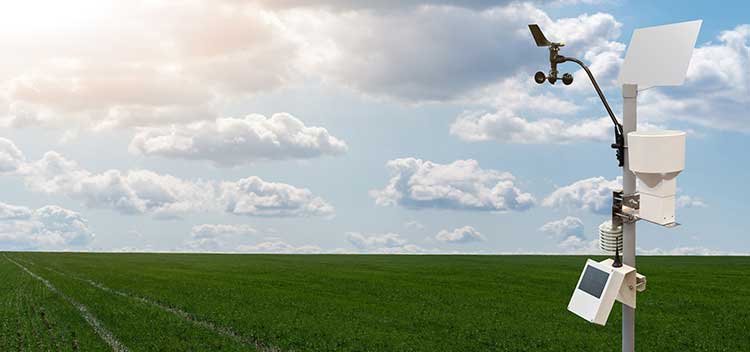Asthma and Allergy Forecast
What the Forecast Means
Asthma index: a combination of weather factors that can trigger asthma symptoms. A higher index value means more people with asthma will potentially be affected by weather factors, such as changes in temperature or allergens in the air.
Allergy index: a combination of weather factors and plant growth stages that increase the release and airborne spread of pollen. A higher index value represents a high pollen count and/or spread of pollen.
Flu index: a combination of historical flu data and temperatures. The index represents the degree to which transmission of the virus is favorable. A higher flu index means the spread of a flu virus is very favorable, assuming the disease is present.
The colored bars atop each index represent where the data currently stands based on the forecast date. Each index is scaled from 0 to 10, with 0 being very low and 10 being very high. The further to the right the tick mark is, the higher the index level.
This tool allows you to have a personalized index for the pollen count today in your area. Do you need an allergy forecast in NYC? How about a Dallas allergy report? Or perhaps you’re looking for an Austin, Texas allergy report or an Oklahoma City allergy report? The index provides you with an asthma and allergy report so you can find out if allergies are bad right now in your area. No matter where you live, we’ve got you and your local weather covered.
How to Monitor the Weather to Manage Allergies and Asthma
If you live with asthma or allergies, managing your triggers to avoid symptom flare-ups is a part of everyday life. Environmental allergens such as pollen and mold are common triggers. You may not realize that changes in the weather can also affect your asthma and allergies.
Weather conditions such as temperature changes, humidity changes, thunderstorms, rain and wind can inflame the airways, leading to flare-ups. People with respiratory conditions tend to breathe through the mouth and doing so brings weather-related irritants directly to the lungs. It also doesn’t allow your nose to regulate the humidity and air temperature.

How does the weather affect symptoms?
- Humid air is moist and heavy. When the air is stagnant, air quality goes down, making breathing harder for everyone. It can trigger an asthma and allergy flare-up since mold and bacteria grow better in moist environments. Humid weather can worsen allergy symptoms.
- Hot weather often impacts air quality. Ozone can rise to dangerous levels, irritating your respiratory system. Increased traffic, exhaust, smog and other pollutants can make breathing harder if you have asthma.
- Cold, dry air may seem better for your breathing than hot, humid air, but unfortunately, breathing it in can make the bronchial tubes constrict and spasm as they try to keep airways open, making symptoms worse.
- Thunderstorms bring barometric changes, high humidity and winds that blow pollen and mold spores everywhere. This can lead to a phenomenon called thunderstorm asthma. In addition, lightning generates nitrogen oxides that can impact ground-level ozone, irritating the lungs and airways.
- Changing weather patterns alter barometric pressure, which can trigger sinus problems and make breathing harder if you have asthma.
What’s the pollen forecast?
Pollen comes from blooming grasses, plants, trees and weeds. It is carried far and wide by the wind. You might be allergic to one kind of pollen and not another.
Pollen counts vary with the weather and location, so pollen allergies differ dramatically from person to person. For this reason, it’s essential to know which types of pollen will trigger your allergy symptoms. Monitor your area’s pollen count daily. Work with your doctor to avoid exposure and treat symptoms.
Pollen counts measure how much pollen is in the air on a given day. Scientists use air sampling devices to collect particles from the air and then analyze them. They identify types of pollen as well as how much of each is in the sample. A pollen count covers a large area since pollen is airborne and is measured by grains of pollen in a cubic meter.
Government agencies, universities and commercial research institutions measure pollen counts to provide information to the public. They also determine how different allergens affect people and develop medications and treatments for allergy sufferers.




What allergens are in the air today?
Checking the pollen count is only the beginning. Mold spores are also a problem for many people with allergies and asthma. With vigilance and elbow grease, people with mold allergies can keep indoor mold and mildew at bay.
It’s a different story outdoors. Mold spores and seeds fly through the air from late spring through fall and grow on decaying leaves, compost piles and grasses. It peaks during the summer with hot, humid weather.
Mold never really goes away. Snow can cover mold but rarely kill it. Windy, rainy weather during any season sends spores airborne.
Check your local pollen and mold counts. Using a website or local allergy forecast app can help you plan your daily activities and manage your symptoms.
Visit the National Allergy Bureau at AAAAI.org/nab for pollen count information. Visit airnow.gov for Environmental Protection Agency air quality alerts. Both websites also have apps available for smartphones and tablets.
How to manage weather allergy symptoms
The key to managing allergy and asthma symptoms is knowing your triggers. You might find cold air ramps up your asthma symptoms. Pollen might bother you a bit, or it can make you miserable.
Asthma and allergies are unique to each person, so identifying what worsens your symptoms is vital. Ideas that may help:
- Use an app or weather forecasting site to keep an eye on potential changes that might affect you. Watch the pollen count, mold spore count, air quality index, humidity, temperature and changes in barometric pressure. Sign up for alerts via email or text.
- Limit outdoor exercise in weather that affects you or if the air quality is poor.
- Wear a mask when gardening or cutting grass to limit particles and mold spores.
- Use a scarf to shield your mouth and nose in cold weather. It warms and humidifies the air before you breathe it in, reducing shock to your airways.
- Keep humidity levels in your home steady. Air conditioning, dehumidifiers or humidifiers, as needed, can help keep your airways from becoming inflamed.
- Take all your asthma medication as prescribed. These help you control your asthma daily and during a flare. Follow your doctor’s advice.
How does weather impact asthma symptoms?
Answer: Weather can significantly impact those with asthma. Sudden changes in the weather and extreme heat or cold can trigger asthma symptoms. Windy conditions can spread pollen allergens, another asthma trigger. Asthma symptoms include coughing, wheezing, shortness of breath and chest tightness. Before diving deeper, it’s important to define what is asthma. Asthma is a chronic condition that affects the airways, causing them to swell and produce extra mucus. Since extreme weather conditions can prompt asthma symptoms, it’s essential to monitor the weather and take precautions. Use asthma controller inhalers every day as prescribed and limit outdoor exposure, when necessary.
How does seasonal weather impact allergies?
Spring
When most people think of allergy season, they think of springtime when plants come to life and pollen and mold invade the air. Warm weather and rainfall in spring aids plant growth. Showers may offer allergy patients a break – moisture weighs down the pollen, keeping it on the ground. Depending on where you live, tree pollen levels are highest in April and May – earlier in southern and southwestern states. Grass pollen levels start to rise in late spring and early summer.
Summer
Grass pollen is at its peak from late May through early July, when dry, breezy conditions spread pollen. Thunderstorms with heavy winds can spread allergens further – especially small particles of pollen that are inhaled more easily and go deeper into the lungs.
Fall
Ragweed season begins in late summer, peaking in September and typically ending by the first frost. One of the most potent allergens, ragweed makes life miserable for many with nasal and eye allergies. Warm temperatures, reduced humidity and breezy conditions create the ideal environment for ragweed plants to release pollen.
Winter
People in the Southwestern United States, Mexico and Japan may experience winter allergies to the Ashe Juniper tree – commonly referred to as mountain cedar. This tree releases its pollen every year from December to February. For most other people living in areas with cold weather, winter is a welcome outdoor respite from allergies. However, keep an eye on weather patterns. A mild winter can cause plants and trees to pollinate early – especially if there’s a lot of rain – leading to an early start to spring allergy season. Moisture from snowmelt in late winter can cause trees to produce more pollen when they bloom.

How does climate change impact seasonal allergies?
Many scientists and doctors think climate change is a factor behind the recent extreme pollen seasons and rise in seasonal allergies. Fueled by higher temperatures and milder winters, plants bloom earlier and for longer periods of time in many parts of the country. The extended growing season means higher levels of pollen in the air and worsened allergies for many people.
Many people with allergies experience worse seasonal allergy symptoms when early spring weather fluctuates between warm and cold. This is called the “priming effect.” When there’s an early warm spell, trees and grass release a first round of pollen. The resulting allergic reaction “primes” a person’s immune system for more severe pollen reactions later in the spring.
During longer allergy seasons with high pollen counts, allergy patients may find they need to use more medication to manage symptoms. Talk with your doctor about whether you should adjust your allergy management plan or medication schedule. Your doctor can also discuss whether allergen immunotherapy for pollen is right for you.




